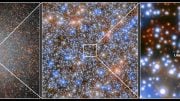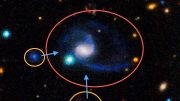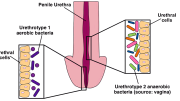The two-dimensional semiconductor material molybdenum disulfide is filled with electrons (red spheres). The electron-electron interaction causes the spins of all electrons (red arrows) to align in the same direction. The exchange energy required to flip a single electron spin in the ferromagnetic state can be determined by the separation between two specific spectral lines. Credit: N. Leisgang, Harvard University, formerly Department of Physics, University of Basel/Scixel
A study has extended the scope of ferromagnetic materials to include molybdenum disulfide, showing it can exhibit similar properties to iron under certain conditions. This includes measuring the energy needed to modify its electron spins, highlighting its potential stability and usefulness.
Ferromagnetism is an important physical phenomenon that plays a key role in many technologies. It is well-known that metals such as iron, cobalt, and nickel are magnetic at room temperature because their electron spins are aligned in parallel — and it is only at very high temperatures that these materials lose their magnetic properties.
Discovering New Ferromagnetic Properties
Researchers led by Professor Richard Warburton of the Department of Physics and the Swiss Nanoscience Institute of the University of Basel have shown that molybdenum disulfide also exhibits ferromagnetic properties under certain conditions. When subjected to low temperatures and an external magnetic field, the electron spins in this material all point in the same direction.
In their latest study, published on July 8 in the journal Physical Review Letters, the researchers determined how much energy it takes to flip an individual electron spin within this ferromagnetic state. This “exchange energy” is significant because it describes the stability of the ferromagnetism.
Detective Work Yielded a Simple Solution
“We excited molybdenum disulfide using a laser and analyzed the spectral lines it emitted,” explains Dr. Nadine Leisgang, main author of the study. Given that each spectral line corresponds to a specific wavelength and energy, the researchers were able to determine the exchange energy by measuring the separation between specific spectral lines. They found that in molybdenum disulfide, this energy is only about 10 times smaller than in iron — indicating that the material’s ferromagnetism is highly stable.
“Although the solution seems simple, it took considerable detective work to allocate the spectral lines correctly,” says Warburton.
2D Materials in Modern Technology
Two-dimensional materials play a key role in materials research thanks to their special physical properties, which are the result of quantum mechanical effects. They can also be stacked to form “van der Waals heterostructures.”
In the example seen in this study, the molybdenum disulfide layer is surrounded by hexagonal boron nitride and graphene. These layers are held together by weak van der Waals bonds and are of interest in the fields of electronics and optoelectronics thanks to their unique properties. Understanding their electrical and optical properties is vital in order to apply them to future technologies.
Reference: “Exchange Energy of the Ferromagnetic Electronic Ground State in a Monolayer Semiconductor” by Nadine Leisgang, Dmitry Miserev, Hinrich Mattiat, Lukas Schneider, Lukas Sponfeldner, Kenji Watanabe, Takashi Taniguchi, Martino Poggio and Richard J. Warburton, 8 July 2024, Physical Review Letters.
DOI: 10.1103/PhysRevLett.133.026501









The two-dimensional semiconductor material molybdenum disulfide is filled with electrons (red spheres). The electron-electron interaction causes the spins of all electrons (red arrows) to align in the same direction. The exchange energy required to flip a single electron spin in the ferromagnetic state can be determined by the separation between two specific spectral lines. In their latest study, published in the journal Physical Review Letters, the researchers determined how much energy it takes to flip an individual electron spin within this ferromagnetic state.
Please ask researchers to think deeply:
1. How do you confirm that the semiconductor material molybdenum disulfide you observe in the experiment be two-dimensional?
2. What is the difference between 2D and 3D?
3. Why do electrons spin?
4. Where does the power of electron spin come from?
5. Is electron spin related to topological spin?
6. Do you really understand the spacetime structure of electrons?
7. Why can vortices be seen in spacetime?
8. Where does the force of vortex spin come from?
and so on.
The Physical Review Letters firmly believes that two sets of high-dimensional spacetime objects (such as two sets of cobalt-60) can rotate in reverse and form two objects that mirror each other. Is it a reputable scientific journal? Don’t you feel ashamed to publish articles in such publications?
Please witness the exemplary collaboration between theoretical physicists and experimentalists (https://zhuanlan.zhihu.com/p/701032654).
I hope researchers are not misled by the erroneous theories in the Physical Review Letters (PRL). Scientific research guided by correct theories can help humanity avoid detours, failures, and pretension.
How nothing’s can gives birth to something in existence 🤔
Or Nothingness is an illusion from the limitation of human mind capacity to comprehend universe action reaction or interaction of elementary particle or wave or something is missing very badly from our observation to comprehend the same….✍️
Very good!
Space has physical properties of zero viscosity and absolute incompressibility. Zero viscosity and absolute incompressibility are physical characteristics of ideal fluids. The space with ideal fluid physical characteristics forms vortices via topological phase transitions, which is not difficult to understand mathematically. Once the topological vortex is formed, it occupies space and maintains its presence in time. This is the transition from chaos to order via two bidirectional coupled continuous chaotic systems.
If you are truly interested in science and physics, you can browse https://zhuanlan.zhihu.com/p/695926158.